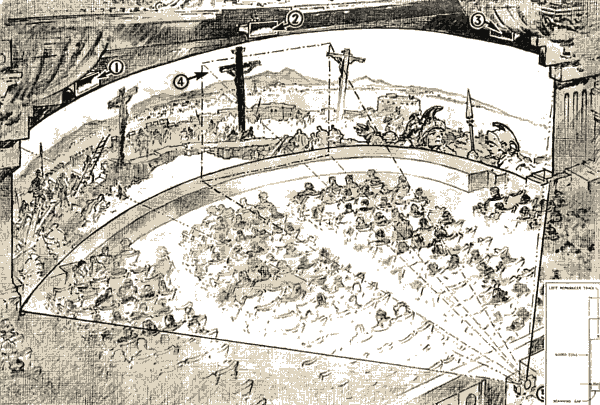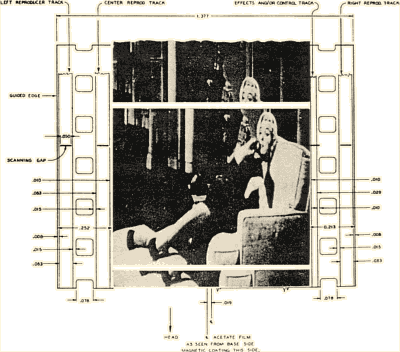CINEMASCOPE


CinemaScope projection is illustrated in the sketch above. The scene pictured on the Miracle Mirror Screen is from "The Robe." Dotted lines (4) show the size of the conventional screen as compared to the new concave Miracle Mirror screen.
CinemaScope picture is made possible by the anamorphic lens that condenses the scene in filming, but expands the image to illustrated giant screen proportions in projection.
New dimensional sound effect is produced by the trio (1, 2 and 3) of "sound" boxes (but, in actual practice, from behind.)
The historic new development in motion picture projection of CinemaScope pictures is detailed in the summary at the bottom of this page. The new system enables exhibitors to use standard projection equipment (5), requiring no extra projectors, with only simple and economical changes involved in the single-film stereophonic process.
In contrast to the comparatively few changes in the old projection system, conversion of production to CinemaScope was a Herculean task achieved in a surprisingly short space of time. It involved re-tooling of 103 departments at the studio. However, within less than two months after the studio received its first anamorphic lens, complete conversion was effected and actual filming started on the first CinemaScope production, "The Robe."

The single-film system (diagrammed at right) is an integral part of the CinemaScope process. The new process comprises the use of a 35-millimeter single-film in a stereophonic sound system. The process combines, for the first time, a picture and four magnetic tracks on one mim strip and obviates the need for separate sound reproducer formerly required for be projection of stereophonic sound.
Thus, exhibitors continue to use standard projection equipment, requiring no extra projectors, with only simple, practical and economical changes involved. To accommodate the four magnetic sound tracks,the sprocket holes of standard 35-millimeter film have been narrowed from .110 to .078 inches. Two of the tracks are placed on either side of the picture.
Changes in the projector are a slight reduction in width of the teeth of the intermittent and other sprockets, and the addition of a simple multiple film-driven sound head installed between the upper magazine and the regular projection head. With these changes, the standard theatre projector becomes compatible not only with CinemaScope projection, but with every existing film-and-sound system as well. The new sound head is produced by General Precision, RCA, Altec and Westrex.
Feasibility of the four-track single-film system stems from the present-day utilization of acetate film which, unlike the old-fashioned nitrate film, has practically no shrinkage and, therefore, permits the use of smaller sprocket holes.
The total cost of equipment required for perfect exhibition of CinemaScope pictures varies, of course, according to size and other dimensional facilities of individual theatres. However, it may be reported that a 720-seat theatre in Albany, Ore., had the necessary equipment installed at a cost of $8,325. The operator of this theatre personally confirmed this figure at a recent convention of Theatre Owners of America in Chicago.
Messrs. Skouras and Lichtman have both, at various conventions of exhibitors' organizations, stated that this company would help any honorable theatre owner to obtain credit from equipment firms so he can equip his theatre properly for the exhibition of CinemaScope attractions.
The universal trend of motion picture exhibition is, judging from the past two months, definitely to CinemaScope.